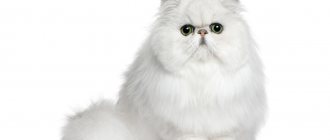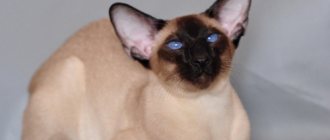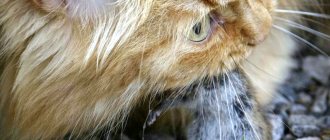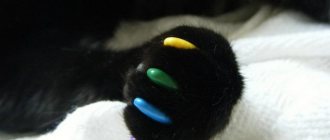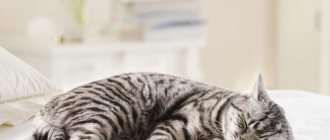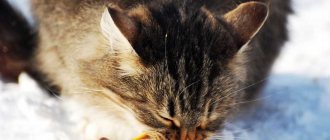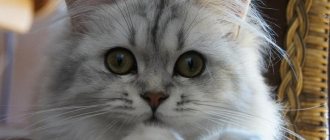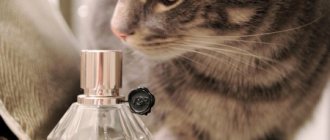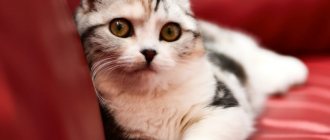The dream of many children is to have their own pet, and often a cat. Cats often serve an important role for children: they provide constant contact, keep secrets, and listen. The purring is soothing, and watching the animal play is a pleasure.
In preschool age, children learn better how to carefully and properly handle pets. At this age, children can help care for the cat under the supervision of their parents. However, of course, we must not forget that each animal has its own character, likes and dislikes. Consider below which cat breeds are still suitable for children.
American Curl Shorthair
"Curl" means "wrinkled" and this leads to the characteristic feature of this cat breed - its ears curled back. This feature arose as a result of a random mutation and was specially bred.
This is a family cat par excellence due to its pronounced good nature. She is gentle and forgiving towards small children. With older children she enjoys more daring games. A little wary of strangers. She enjoys cuddling with her owners, although she usually has a main reference.
The American Curl Shorthair also gets along very well with other pets, whether they are other cats or dogs. The cat is a very sociable cat who definitely doesn't want to be left alone. Despite their balanced, rather calm character, cats of this breed need a lot of exercise.
The noticeably curled ears are a trademark. Depending on the degree of inclination, they are more or less bent back. The coat is short, smooth and silky, with almost no undercoat. All colors are allowed. Females weigh up to 7 kg, males - up to 12.
Be sure to involve your child in the choice, do not give a personal gift - a pet
Also pay attention to the character, temperament of your baby, whether he has diseases (for example, an allergy to wool), the size of the apartment, income (some breeds of cats require certain and obligatory expenses). All worries will still fall on you, think about it - do you need this? Or is it easier to refuse your child? If your answer to the first question is yes, then move on to our rating of kitten breeds for your children!
The oldest cat breed in the world, the Persian is a loyal, gentle, non-obsessive, and affectionate pet with a balanced character, who loves to sit in arms and cuddle. The owners note a certain patronizing and condescending attitude on the part of the pet. Not suitable for noisy hours, for children and adults with allergies; they constantly need to take care of the coat, comb out tangles, while at the same time receiving a portion of communication.
Bombay
Bombay was created in the USA in 1958. In the late 1950s, American breeders wanted a cat that had the texture and appearance of the Burmese, but also had a deep, glossy black color. This breed would resemble the Indian black leopard. To this end, a breeding program began for the Burmese and the black American Shorthair cat with light copper eyes. The resulting cat was named Bombay after the black leopard, which she actually resembles. Bombay was recognized as a "show cat" in the late 1970s. Although Bombays are still not common, they attract the attention of the public at any exhibition in which they are presented.
The Bombay impresses with its elegant appearance and shiny coat. Despite its bright appearance, this breed is not wild or arrogant; on the contrary, it is very pleasant and peaceful.
Bombay is quite intelligent and, due to his high intelligence, especially enjoys more demanding games, which should never become fast paced. Because she needs a lot of rest and a refuge in which she can retire if necessary. However, in most cases, the cat wants to be noticed by its owners, sometimes they demand this quite annoyingly.
Smart Bombay is trained to walk on a leash and is one of those jokingly called "dog cats." The cat does not require special care, but to keep its coat shiny, it should be brushed several times a week.
The most striking thing about Bombay is his black, silky coat. The build is petite but athletic. Females weigh on average 4 kg, and males - 5 kg. Black fur is dominant, but sable kittens are sometimes born, and some associations allow these kittens to be registered as Burmese. The Bombay's eye color ranges from gold to copper.
Which breeds are better not to choose?
If a pet is needed in the house as a playmate for a child, special attention should be paid to the interaction of the animal with people.
What breed of cats are not chosen for children:
- Ragdoll. Genetically fixed incredibly calm temperament. It is very difficult to make such a cat play and run. She is not aggressive, but overly melancholy.
- Persian. These cats are irritable and dislike noise and children's activity. If you force your dog to play, he may bite.
- American Curl. Friendly and playful, but this breed is not suitable for children - Curls do not like cuddles and children's hugs.
- Himalayan. Not suitable due to its long, beautiful coat, which requires considerable effort to tidy up.
- Turkish Angora. Prefers the company of adults, communicating with them through sounds.
All long-haired breeds for children are not an ideal option, because during play the hair will be in the child’s mouth, and the injured animal will begin to show aggression.
Important! Children do not need representatives of recently bred breeds with loose character traits.
Turkish Angora
The noble Angora celebrated success as one of the oldest cat breeds of the Ottoman Empire. It was recognized as a breed back in the 15th century. Angora" is the old name of Ankara. For a long time, the Angora cat was understood as all cats with long hair, mostly white. The term is still used today outside of specialist circles and is sometimes used colloquially as a synonym for Turkish Angora.
This breed arose without human intervention. She is distinguished by her special loyalty, which is often compared to dogs. Because she follows her guardian every step of the way. Most of the time she hopes to be petted, as she needs a lot of love and pleasant sensations. The Turkish Angora is usually an easy-going personality that gets along well with everyone: with its relatives and other pets such as dogs, and, of course, with its owners.
This breed is an excellent playmate for children. Because their joy from playing practically knows no bounds and hardly diminishes with age. The cat also likes to fetch smaller toys, which regularly excites children. She attracts attention by purring and stroking her legs. If a cat feels neglected, it may become withdrawn. In addition to careful care, she also needs a lot of space to be able to live to her satisfaction. The cat has semi-long, silky fur that fits tightly to the body because it has no undercoat. The colors are white, black and red with different shades. The body is long and slender, at the same time muscular, although the cat looks fragile. Even male cats hardly exceed 4 kg.
The best breeds for children
It is advisable that parents do not give their child a long-awaited pet, but choose it together.
Important! There are a number of breeds that breeders have been working on for a long time, selecting and purposefully developing qualities that are important for life in a family, in an apartment - a guarantee that the character of a cat is easy to predict, it quickly adapts to the home and over the years becomes an excellent companion for a child.
What qualities are valued in an animal destined to become a friend and grow up with a baby?
| Patience | Children can accidentally hurt the cat. Many cat breeds take this calmly, realizing that a human cub is not an aggressive enemy. |
| Low level of territoriality | At the genetic level, cats strive to protect their territory, but a cat in the house must understand that people, even small ones, are above it in the hierarchy. |
| Activity level | Of course, playful breeds are suitable for children and are fun to play with. A passive animal that sleeps most of the time will not suit children. The cat should enjoy interacting with humans. |
| Lack of defensive-aggressive reaction | When frightened, a cat may scratch or bite. This is a normal reaction. But animals that specifically lie in wait for a person and attack from around the corner are not suitable for children. Vicious and aggressive cat breeds are very rare, but it is still worth excluding them from the list. |
| Stress resistance | Yes, children are noisy, so the animal must have a high level of stress tolerance. A timid or nervous pet will not get along in a family with children. |
It is worth considering in detail those breeds on which breeders have worked well.
Abyssinian
The Abyssinian's roots are in Southeast Asia, and they are one of the most bred cat breeds in the world. It came to Europe in the 19th century and was registered in Germany in 1933. Like many other cat breeds, the Abyssinian's survival was threatened during and after the two world wars.
No matter how many animals live in a farm that provides entertainment, the Abyssinian is very human-oriented. The Abyssinian cat looks at people with curiosity, and especially at children. A smart kitten carefully records every action. Cats love children very much, and boredom and excessive rest are out of the question.
The Abyssinian is slender and finely built, with long legs. Reaches a shoulder height of 40 and a length of 60 cm. Cats weigh from 2.5 to 4 kg, males - from 3.5 to 5 kg. The coat is short and has no pattern in purebred Abyssinians.
The short coat of the Abyssinian does not require special care. It should be brushed from time to time; cats shed in the spring. She needs a lot of attention, movement and variety.
How to choose the right kitten and why should you choose cubs?
Cats are very special creatures. As you know, dogs get used to their owner, and cats get used to the house in which they live. It is best if the kitten is brought into the apartment at the age of 3-4 months and lives there all its life. He will consider this area his territory and will not make any attempt to get outside.
An adult cat will react to moving in the most negative way. At a minimum, he will begin to mark a new territory (and this will cause a lot of trouble for the owners), and at maximum, he may refuse to eat, begin to show aggressiveness and completely forget the way to the tray. In order to avoid such difficulties, it is best to buy a pet when it is small, and then the question of which cat is best to have in an apartment will not be so pressing.
And in order to choose the most worthy kitten in the litter, you must adhere to the following rules:
• Place of purchase of the animal.
The best option is to purchase a kitten from a specialized nursery. In such a place, purebred animals are bred and each kitten that appears is initially under the supervision of a veterinarian. From birth, he undergoes inspection, culling and has an appropriate passport confirming his pedigree. Of course, buying a bundle of joy in such a place is inexpensive, but the buyer is guaranteed to receive a quality product. Moreover, the owners of the cattery will always suggest the best cat breeds for an apartment and teach you how to properly care for a new family member. But it is best to refuse to purchase a cat from strangers or through an advertisement. It is easy to run into an animal with an unstable psyche or a congenital genetic disease.
• Pet's age.
If the future family member is less than 3 months old, then there is no need to rush into purchasing it. The kitten has not yet gone through “cat school”, the mother cat has not taught him all the wisdom, and he vitally needs mother’s milk. In addition, it is at the age of three months that the animal receives its first vaccination, and a passport is issued for it.
• Ease of movement and pleasant appearance.
Abyssinian cat – photo from the site www.catsofaustralia.com
It is well known that cats are very clean and tidy creatures. If the kitten's fur is in poor condition, it is wrinkled, does not shine and is not well-groomed, then the animal is clearly sick and is unable to care for itself. In addition, the kitten should not be too thin and not too fat. Any deviation from the norm is a reason for culling the animal. Also, the fluffy one should be playful and move easily. Kittens at the age of 3-4 months are very playful and active, and show commendable curiosity. If the baby is passive and constantly sleeps, then it should not be purchased. The future pet must be beautiful and active. In addition, this indicator should be taken into account especially when answering the question of what breed of cat to choose for a child.
• Ears, eyes and tail!
Ears, eyes and tail - these are the kitten's documents! The condition of these parts of an animal's body can tell a lot about its health. What breed of cat is best for a child? The one who is healthy and gets along well with children! If the animal’s ears and eyes are clean, without discharge or unpleasant odor, then the animal, at a minimum, does not have birth defects. Under the kitten’s tail is dry and clean - a guarantee of the absence of problems with the digestive system and gastrointestinal tract.
• A good appetite.
When you go to choose a future family member, you should take some cat treats with you. If the kitten happily accepts food from your hand, then there will be no problems with feeding at home. And if he refuses, then something is clearly wrong with the animal.
Which breed of cat to choose depends only on you, but a kitten of any breed must fully meet the above requirements.
Norwegian forest
The breed has been specially bred only since 1930, Norwegian Forest cats have no hereditary diseases and usually have good health.
However, the athlete cat is extremely active, a gifted climber, and constantly fulfills her desire to move. Throughout her life, she has enjoyed playing outdoors, even in inclement weather.
The beautiful Norwegian is not a cat that needs to be looked after from morning to night. On the contrary, it is economical in care.
The Norwegian Forest Cat is very affectionate with children and enthusiastically spends time with them. Due to its gentle nature, this cat is also suitable for families with small children, to whom it treats with great attention. Because she is straightforward, open-minded and quite tolerant.
The Norwegian Forest Cat is an imposing figure. This is due, on the one hand, to their size (shoulder height 45 cm, females weigh from 3.5 to 7 kg, males from 5 to 9.5), on the other hand, to their half-length body, which is especially thick in the area neck. It consists of a dense undercoat and a long, dense topcoat. The body is strong and athletic.
The Norwegian Forest Cat is easy to care for. She does not need constant outside employment and, as a rule, she is quite thrifty. Because the top coat repels moisture and dirt, your cat only needs to be brushed once a day. In principle, even once a week is enough.
Which cat is best for a child?
Each cat breed has its own characteristics, which it is better to know about in advance, and its own character. If there is a child in the family, it is of course better to choose a cat among non-aggressive, friendly, playful breeds. Before purchasing, familiarize yourself with the characteristics of the breed and prepare for possible difficulties.
If you have decided on a breed, pay close attention to the breeders . Unfortunately, there are now more and more people who are trying to make money from breeding without caring about the health of the animals. A low cost may indicate that the animal was raised in poor conditions and fed cheap food, without veterinary control, or the kittens were the result of inbreeding. Such cats can have a number of serious defects and diseases.
It is important for parents to remember: no matter what animal they get, they must carefully monitor the health of their pet. Firstly, we are responsible for those we have tamed, and secondly, our smaller brothers themselves can become carriers of some diseases dangerous to humans if basic prevention rules are not followed.
Be sure to visit a veterinarian for a preventive examination and vaccination at least 1-2 times a year. At least 2 times a year, you should drive away worms with special means: even if the cat sits in the apartment forever, you yourself can bring helminth eggs or dangerous viruses from the street on your shoes. When going outdoors, don’t forget to treat your fur against fleas and ticks.
It is also better to immediately discuss with your doctor the method and timing of sterilization of the animal : this will protect the cat from a number of diseases and improve its disposition. Teach your child to always maintain hygiene and wash their hands after contact with an animal. A healthy cat can become a true friend to you and your children and a full member of the family for many years.
British Shorthair
The British Shorthair originated quite accidentally in 19th century Britain from domestic cats that once arrived on the island with the Romans, and various breeds. The thick fur looks like plush.
The British Shorthair cat is very fixated on people and absolutely demands attention - anywhere and at any time. The shy cat usually gets along well with other animals, especially if they have been socialized from an early age. Despite all its coziness, the powerfully built British Shorthair is also a good hunter who persistently pursues its prey.
The cat is stocky - this is due to thick hair, on the one hand, and a strong physique, on the other. Females weigh from 4 to 6 kg, males - from 7 to 8. Fur colors are very varied, but the ash color is especially popular among breeders and owners.
The nature of pets living in the apartment
To shape the character of a pet in the right direction, you need to take the animal into an apartment when it is still a cub, just weaned from its mother. But some animals cannot be trained or raised.
Exotic animals are not suitable for an apartment, especially with a small child.
Firstly, many of them, for example, snakes, are carnivorous. That is, they will periodically consume live food in front of the child - baby mice and frogs.
Secondly, for example, monkeys are characterized by inappropriate behavior; sometimes you need to take care of them even more than a child. And monitor lizards and crocodiles are capable of attacking.
The most child-tolerant dogs are St. Bernards, Newfoundlands, spaniels, German shepherds, Labradors, boxers, schnauzers, Airedales and mongrels.
Charming toy terriers, dachshunds, Italian greyhounds and greyhounds, bulldogs, bull terriers, and South Russian shepherd dogs get along well with children.
Among cats, experts consider Angora, Burmese, Himalayan, Manx, Korat, Burmese, Ragdoll, Burmilla, and Russian Blue to be the friendliest.
It’s up to you to decide which animal is best to have in your apartment, but remember some rules.
After two years, the baby is able to learn the rules of behavior with animals.
Prohibit your child from taking food from the animal, pulling its paws, ears and tail, and not lying on it.
Teach your child to follow the rules of hygiene: do not kiss the animal, especially on the nose where there is a lot of bacteria.
Wash your hands after every interaction.
Choose an animal to live in an apartment with your children. That's all - collar, leash. Try to buy a cage together with your child. This way the child will immediately feel responsible for the pet.
Siberian
It acquired its current appearance in Russia. It also came to Western Europe in the 80s of the 20th century. In 1998, the International Cat Federation recognized Siberian cats as a separate breed.
Children love them and can play and tinker with them for hours. At the same time, the cat never becomes aggressive and is especially attentive to small children.
Thus, the Siberian cat is a true family cat that gets along well with everyone. However, she usually has a loved one who loves her especially. Despite all the affection, the Siberian cat, like all representatives of natural breeds, is an excellent hunter with a great impulse to move.
The Siberian cat has semi-long, silky hair that comes in different colors and a fluffy tail. The body is quite large and muscular. Females weigh on average 4.5 kg, males 6 kg. The eyes are slightly slanted and come in a variety of colors, especially bright blue. Caring for a Siberian cat is similar to caring for a domestic cat. The Siberian cat needs a lot of exercise and affection.
Outbred
It is unknown what character traits a cat adopted from the street or from a shelter has. She may turn out to be a playful fidget, a calm aristocrat, or a feisty one.
However, most often, street kittens quickly become attached to a person and accept the rules of behavior in the apartment.
Such cats are not very sociable - this is fixed at the genetic level. But the former homeless animal is self-sufficient, not annoying and unobtrusive. At the same time, an even, warm relationship is built with children, but the kitten is unlikely to allow itself to be commanded.
After adopting an animal from the street, owners need to do a full veterinary examination.
Peterbald (Petersburg Sphynx)
Although hairless cats were bred primarily through Sphynx cats, they remain a very popular sight. However, they can be a boon for allergy sufferers. The Peterbald, like other representatives of this category, is a wonderful, sweet cat.
Peterbald owes its name to the Russian city of St. Petersburg. There he was first bred in 1994 from a pair of Don Sphynx and Oriental Shorthair.
Like its close relatives, the Peterbald is very attached to people. He prefers to cuddle and play with his loved one. He is also very open towards all residents in the house, including other pets, which he treats with great tolerance.
Peterbald especially appreciates children because they are as playful as he is. The Peterbald has no fur, only a little fluff. This is their most noticeable feature. The cat itself is slender and muscular, and can weigh up to 4 kg. The Peterbald does not require any grooming, but the skin must be protected from cold and sunlight.
The calmest and kindest cats
Many people prefer to have purebred cats. Among the huge variety of breeds, how can you choose the one that is best suited for living in the same apartment with your child?
There is a rating of representatives of the cat family, as if specially created for families with children. It includes Ragdoll, Devon Rex, Munchkin, Oriental, Scottish Fold, Siberian, Russian Blue, Burmese and hairless cats.
Ragdoll - a “rag doll” for a baby
This is the undisputed leader in the list of the best cats for children. The Ragdoll takes an honorable third place among the largest domestic representatives of this family. Only the Savannah and the Maine Coon are larger. Due to their low muscle tone, these cats have the unique ability to literally go limp in a hug. It is thanks to this feature that they got their name - from English it translates as “rag doll”.
